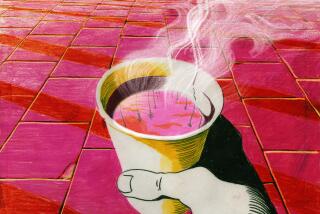A Spicy Mocha
- Share via
In the ‘80s, Americans went nuts for coffee with hazelnut, raspberry and other flavors. Foodies called them depraved innovations, and maybe they were depraved (at least if the coffee were of premium quality to begin with). But flavored coffee is no innovation. Spices have long been added in the Middle East, where coffee originated.
Yemen, which was once the world’s only source of coffee, has a traditional coffee spice mixture, hawaij al-gahwa. It’s ginger, cloves and bishop’s weed, a slightly acrid spice that tastes a bit like thyme mixed with a little cumin.
In the Arabian and Syrian deserts, Bedouins always add cardamom to their coffee. It’s pretty much the sign of Bedouinhood. Pop songs trying to strike a nomad note take care to include lines like, “Make some coffee and don’t spare the cardamom.”
Well, cardamom does have an affinity for coffee; it shows up in some European coffeecakes. So it probably does improve Bedouin coffee, which is rather unevenly roasted in a pan and then used right away, with no time for the bad-smelling gases of roasting to dissipate.
In earlier centuries, spices were sometimes used in Europe, too, where, on top of bad roasting, the coffee beans were often spoiled or adulterated to begin with. Still, it’s surprising to read in Mrs. Martha Bradley’s “The British Housewife” (1756): “And it is now very common for those who like Mustard, to put in a Tea Spoonful of the fine Durham powder [ground mustard] among the coffee as soon as it is ground: This helps the Flavor, and is very wholesome.”
Let’s say that’s a matter of opinion. Not only does mustard lighten the color disturbingly, it makes the coffee harsher.


